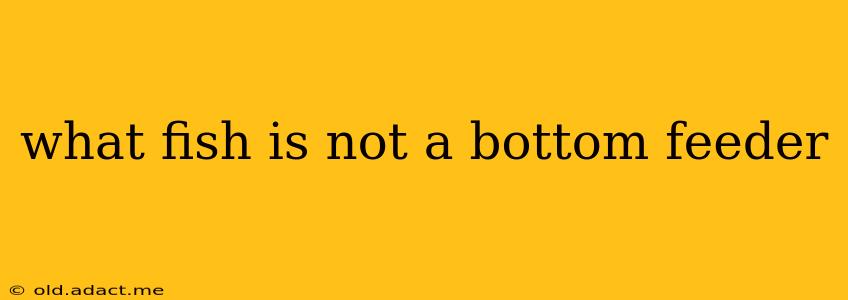Many fish species are known for their bottom-feeding habits, scavenging for food along the seabed. However, a vast number of fish species inhabit other parts of the water column, actively hunting or passively filtering food from the mid-water or surface. This article will explore several fish that are definitively not bottom feeders, examining their feeding habits and preferred habitats.
What are Bottom Feeders?
Before we delve into the fish that aren't bottom feeders, let's define what a bottom feeder actually is. Bottom feeders, also known as benthic feeders, are fish that primarily feed on organisms and detritus found on the bottom of aquatic environments. This includes invertebrates like worms, crustaceans, and mollusks, as well as decaying organic matter. Their mouthparts and body structures are often adapted for foraging on or near the substrate.
Examples of Fish That Are NOT Bottom Feeders:
Many fish species actively avoid the bottom, preferring different feeding strategies and habitats. Here are some prominent examples:
1. Salmon (Salmonidae Family):
Salmon are anadromous fish, meaning they spend part of their lives in freshwater and part in saltwater. They are primarily pelagic feeders, meaning they feed in the water column. Their diet consists largely of smaller fish, crustaceans, and insects, which they actively pursue in the open water. You won't find salmon rooting around on the seabed.
2. Tuna (Thunnus):
These powerful predators are highly migratory pelagic fish. Tuna are renowned for their speed and agility, using their streamlined bodies to chase down prey in the open ocean. Their diet primarily consists of smaller fish, squid, and crustaceans, all caught mid-water or near the surface.
3. Flying Fish (Exocoetidae Family):
These remarkable fish are capable of gliding short distances above the water's surface using their enlarged pectoral fins. They primarily feed on plankton and small crustaceans near the surface, exhibiting a completely different feeding strategy from bottom-dwelling species.
4. Swordfish (Xiphias gladius):
The swordfish, with its characteristic long bill, is an apex predator in the open ocean. They hunt a variety of prey, including squid and other fish, in the pelagic zone. Their hunting style involves ambushing prey from the depths or higher in the water column.
5. Angelfish (Pomacanthidae Family):
While some angelfish species may graze on algae near the reef, many are active hunters, feeding on sponges, corals, and smaller invertebrates found on vertical surfaces or within the coral structure, rather than on the seafloor. They are not typically considered bottom feeders.
H2: What types of fish live in the water column?
Many fish species thrive in the water column, also known as the pelagic zone. These include a wide range of fish with diverse feeding strategies. Pelagic fish can be further categorized based on their depth preference and feeding habits. For instance, some specialize in feeding on plankton near the surface (epipelagic), while others prey on larger organisms in the deeper waters (mesopelagic or bathypelagic).
H2: How do I know if a fish is a bottom feeder?
Identifying a bottom feeder typically involves observing its behavior and physical characteristics. Bottom feeders often have:
- Downward-facing mouths: This helps them feed from the substrate.
- Flattened bodies: This allows them to maneuver easily along the bottom.
- Barbels or whisker-like structures: These sensory organs help them locate food in murky waters.
- Observation of feeding habits: Direct observation of a fish feeding on the bottom confirms its benthic habits.
Conclusion:
While many fish species are adapted to life on the seafloor, a large and diverse group of fish inhabit other parts of the water column. Understanding the different feeding strategies and habitats of various fish species provides a fascinating glimpse into the complex dynamics of aquatic ecosystems. The examples provided here represent only a fraction of the diverse fish that are not bottom feeders, showcasing the rich variety of life found in our oceans and freshwater systems.
